Celtic Cross Spread
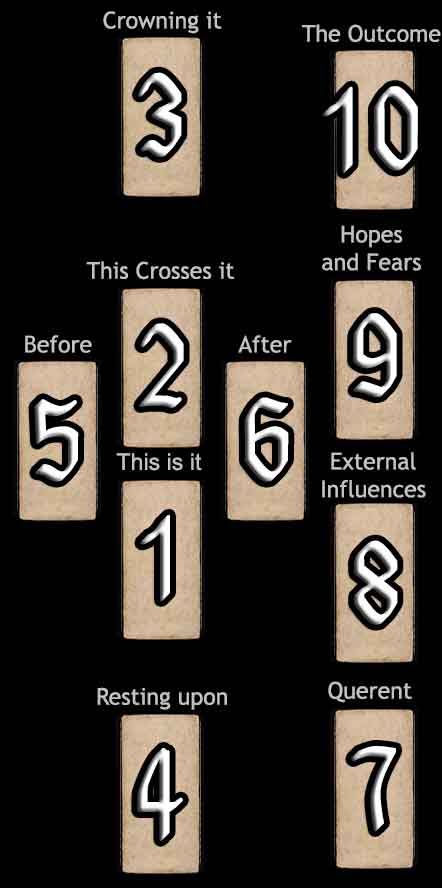
Difficulty: Average
This is probably the most well-known tarot spread. A good, basic spread for beginners to practise with, the Celtic Cross is useful for questions of all types. In this spread, it can be helpful to notice the relationships between the pairings of cards #5 & #9, #1 & #2, #3 & #4, and #6 & #10.
- The significator epitomizes what the reading deals with, the initial situation.
- An added impulse that compounds the significator, which may be either complimentary or contradictory.
- This is what is consciously known (thoughts).
- Unconscious driving forces that may not be known fully (emotions).
- The immediate past regarding the current situation.
- The first future card indicates the immediate future.
- This card represents the reader and their attitude towards cards #1 and #2.
- The external influences, the places and people which influence the topic.
- This tarot card suggests expectations; what is secretly hoped for or feared.
- The second future card reveals the long-term outcome.
Your Celtic Cross Reading
The Crown |
The Outcome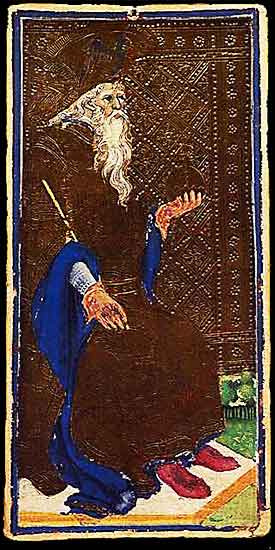 IV – The Emperor
External Forces 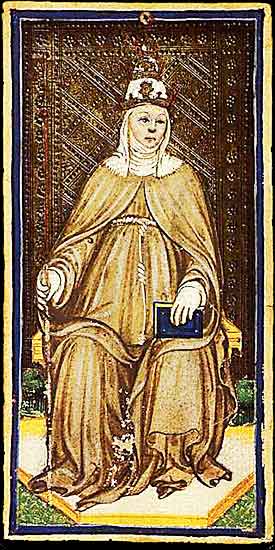 II – The Popess
|
||
The Recent Past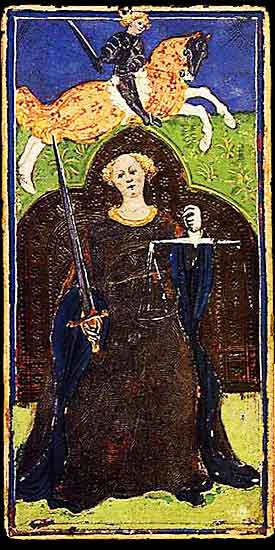 VIII – Justice |
The Crossing Card
|
The Future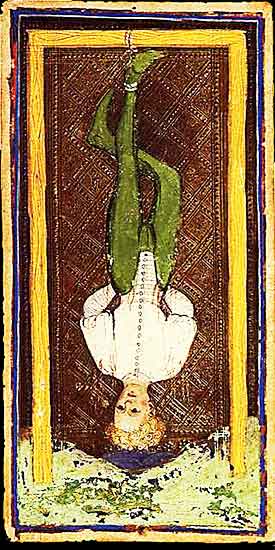 XII – The Hanged Man |
|
|
|||
The Significator represents what the main theme of the reading deals with, the initial situation.
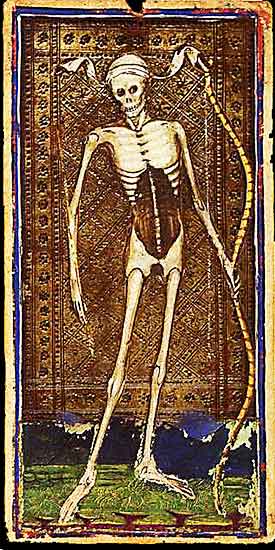
XIII – Death
Death signifies the inevitable conclusion of one cycle and the heralding of another. It's a powerful symbol of transformation, renewal, and the necessity of endings to foster new beginnings.
Symbolism: The skeletal figure with a scythe represents the impartial and unrelenting nature of time and change. The image of fallen bodies suggests the end of a phase, but the subtle floral designs interwoven with the scene offer hope, symbolising rebirth and the cyclical nature of existence. The golden background emphasises the universal truth of transformation and the inevitability of all life cycles.
In Relationships: This card suggests the end of an old emotional pattern or relationship, clearing the way for renewal. Let go of what no longer serves you to make space for new, healthier connections.
In Work: Death marks the close of one professional chapter. It's a time for endings, making way for new opportunities and growth. Embrace the transition instead of fearing it.
Spiritually: Death calls for a transformation, letting go of old beliefs or attachments. Spiritual rebirth requires an embrace of the unknown and a surrender to the cycles of existence.
When ill-dignified: Resistance to change, stagnation, and fear of letting go. This can manifest as clinging to the past or an inability to move forward, hindering growth.
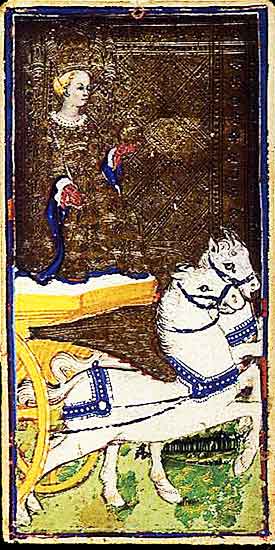
The Crossing Card denotes an added impulse that compounds the initial card, whether complimentary or contradictory.
VII – The Chariot
The Chariot symbolises determination, willpower, and triumph through self-discipline. It represents the ability to move forward and achieve success by mastering conflicting forces.
Symbolism: The stationary horses reflect control rather than speed, while the charioteer's detailed attire and golden background emphasise victory and refinement. The calm pose suggests strength in discipline over chaos.
In Relationships: A time to take charge of your relationship's direction. The Chariot signals progress but warns against domination.
In Work: Triumph through focus and determination. It's a call to harness all resources and overcome obstacles confidently.
Spiritually: The Chariot encourages the mastery of inner conflicts to progress along the spiritual path.
When ill-dignified: Loss of direction, lack of control, or excessive force. It warns against being carried away by ambition or unchecked emotions.
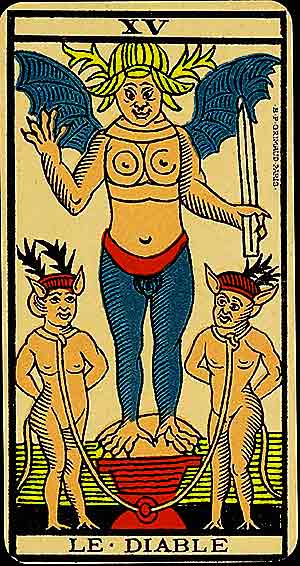
The Crown stands for what the asker is aware of consciously.
XV – The Devil (Lost card, substituted here)
This card no longer exists, so the Marseille version is filling in. The Devil represents bondage, temptation, and the shadow self. It highlights the chains we impose upon ourselves through fear, obsession, or indulgence, urging us to confront these darker aspects to reclaim our freedom.
Symbolism: The Devil embodies primal instincts and the seduction of material or carnal desires. The chained figures symbolise voluntary entrapment, their loose bindings reminding us of the ability to escape our vices. The pedestal signifies false power, while the scene hints at the potential for redemption through self-awareness.
In Relationships: The Devil warns of unhealthy attachments, jealousy, or manipulative relationships. It challenges you to examine whether passion has turned into obsession.
In Work: This card can signify being trapped in a toxic work environment, greed, or overreliance on material success. It urges you to reflect on what fulfils you.
Spiritually: The Devil calls for self-awareness and shadow work. Confronting your inner fears or desires will lead to personal liberation.
When ill-dignified: When reversed or ill-dignified, the Devil signifies breaking free from constraints, overcoming addiction, or realising what binds you.
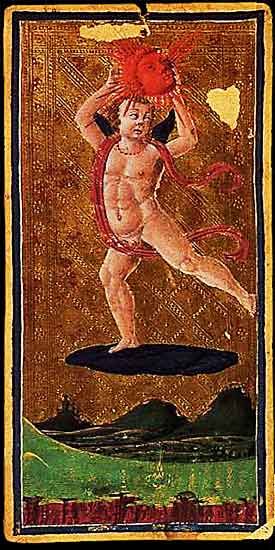
Foundation card reveals unconscious driving forces that the querent may not be aware of.
XIX – The Sun
The Sun represents vitality, clarity, and joyful achievement. It signifies success, enlightenment, and the unyielding energy of optimism and truth.
Symbolism: The child holding the radiant red head is a symbol of pure, untainted joy and triumph. The energetic movement of the figure contrasts with the calm, golden background, reflecting the vitality and dynamic energy of the Sun. This is a card of achievement, where obstacles are overcome through innocence, optimism, and a radiant spirit.
In Relationships: The Sun brings clarity and happiness. It suggests a time of positivity, joy, and mutual growth, where the light of truth shines on all interactions.
In Work: Success and fulfilment are on the horizon. The Sun encourages you to take confident action and bask in the warmth of your accomplishments.
Spiritually: Enlightenment and clarity. The Sun symbolises spiritual illumination, urging you to embrace your true self and the divine light within you.
When ill-dignified: Overconfidence, arrogance, or an inability to see things clearly. The Sun reversed may signal excess or an inflated ego, blinding one to the truth.

The Recent Past represents past events and concerns.
VIII – Justice
Justice represents fairness, balance, and accountability. It signifies the importance of truth and the consequences of one's actions, urging you to act with integrity.
Symbolism: The seated figure holds a sword and scales, embodying fairness and the enforcement of law. The richly adorned gown and golden background highlight the divine and universal nature of justice, while the knight in the background underscores executive authority.
In Relationships: A need for honesty and balance. Justice may signal the resolution of conflicts or the importance of mutual respect.
In Work: Fair rewards for effort and accountability for mistakes. Justice encourages acting with integrity and taking responsibility.
Spiritually: Justice emphasises the law of karma and the importance of living a life aligned with truth and fairness.
When ill-dignified: Bias, dishonesty, or imbalance. It warns against unfair judgements or evading accountability.

The Future depicts that which lies ahead.
VII – The Chariot
The Chariot symbolises determination, willpower, and triumph through self-discipline. It represents the ability to move forward and achieve success by mastering conflicting forces.
Symbolism: The stationary horses reflect control rather than speed, while the charioteer's detailed attire and golden background emphasise victory and refinement. The calm pose suggests strength in discipline over chaos.
In Relationships: A time to take charge of your relationship's direction. The Chariot signals progress but warns against domination.
In Work: Triumph through focus and determination. It's a call to harness all resources and overcome obstacles confidently.
Spiritually: The Chariot encourages the mastery of inner conflicts to progress along the spiritual path.
When ill-dignified: Loss of direction, lack of control, or excessive force. It warns against being carried away by ambition or unchecked emotions.

The Querent represents the asker and their attitude towards the subject of the reading.
XXI – The World
The World represents completion, wholeness, and the harmonious integration of all aspects of life. It is the last card of the Major Arcana, signalling the end of one journey and the beginning of another.
Symbolism: The two ethereal figures holding the globe or portal represent the union of duality and the achievement of balance. The rolling plains and distant mountains beneath the golden sky symbolise the vast potential of the world, and the figures' gesture of offering suggests a celebration of accomplishment. The card evokes cosmic harmony, completion, and the endless cycles of existence.
In Relationships: The World signifies a complete and fulfilling relationship, one where both partners are in harmony and balanced with each other. It's a time of celebration and unity.
In Work: Completion of a major goal or project. The World indicates the successful culmination of efforts, with new horizons opening up in your professional life.
Spiritually: A time of wholeness. The World signifies a sense of fulfilment and oneness with the universe, representing the final stage of spiritual evolution.
When ill-dignified: Incompletion, being stuck, or an inability to move forward. This card warns of a lack of closure or an unfinished journey that hinders your growth.

External Forces represents the influence of others in your life as well as trends in your relationships with others.
II – The Popess
The Popess signifies intuition, mystery, and hidden wisdom. She represents the need to look inward and trust one's inner voice while respecting the unknown and unseen.
Symbolism: Her veil and book symbolise the sacred mysteries she guards. The golden background elevates her presence, while her fancy robes reflect the complexity of her spiritual knowledge. Her composed demeanour conveys her role as a keeper of divine truths.
In Relationships: A time to trust your instincts. The Popess may suggest unspoken feelings or the need for patience.
In Work: Hidden opportunities or knowledge may come to light. Use intuition and discretion when making decisions.
Spiritually: A call to explore inner wisdom and the mysteries of life. Trust the subtle guidance of intuition.
When ill-dignified: Secrets, deception, or an overreliance on logic at the expense of intuition.
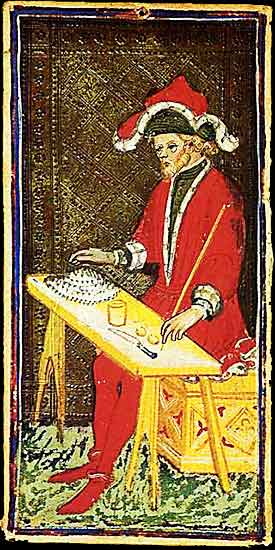
Hopes and Fears shows the expectations you have concerning the outcome of your question.
I – The Magician
The Magician embodies skill, potential, and the power to manifest. He represents the mastery of tools and resources, as well as the confidence to create one's reality. This card speaks of the importance of focus and action in shaping personal success.
Symbolism: The Magician's table holds simple tools, symbolising practical skills and raw materials. His Renaissance attire conveys refinement and expertise, while the golden background suggests his elevated role in shaping the material world. His seated position emphasises composure and control over his craft.
In Relationships: A call to use charm and communication to strengthen relationships. It warns of manipulation if ill-intentioned.
In Work: A time to take initiative and harness your abilities to achieve success. The Magician encourages innovation and confidence.
Spiritually: The Magician bridges the physical and spiritual, reminding the seeker to channel divine inspiration into practical actions.
When ill-dignified: Misuse of skills, deception, or scattered energy. It warns against overconfidence or manipulation.

The Outcome of your question. Interpret this card in the context of the entire reading and as an indicator of the path you are currently on, but not necessarily bound to.
IV – The Emperor
The Emperor symbolises structure, authority, and stability. He represents the power of rules and order to create security and success, though sometimes at the expense of flexibility.
Symbolism: Seated upright with a sceptre and orb, the Emperor exudes control and dominion. His luxurious robes and the golden background emphasise his regal and unshakable power. His stillness reflects his role as a protector of order and enforcer of discipline.
In Relationships: A relationship built on structure and commitment. It can suggest the presence of a protective partner or the need to establish boundaries.
In Work: Leadership, organisation, and discipline are essential for achieving success. The Emperor encourages taking control and assuming responsibility.
Spiritually: The Emperor teaches the importance of structure and discipline in spiritual practice, encouraging grounded growth.
When ill-dignified: Tyranny, rigidity, or abuse of power. It warns against controlling behaviours or excessive adherence to rules.